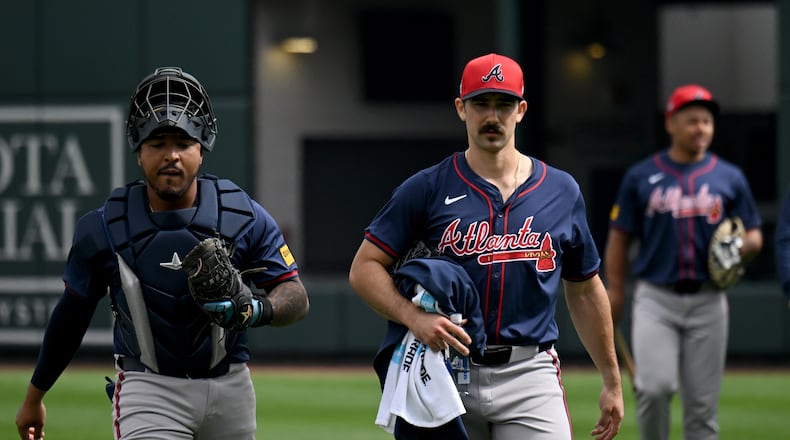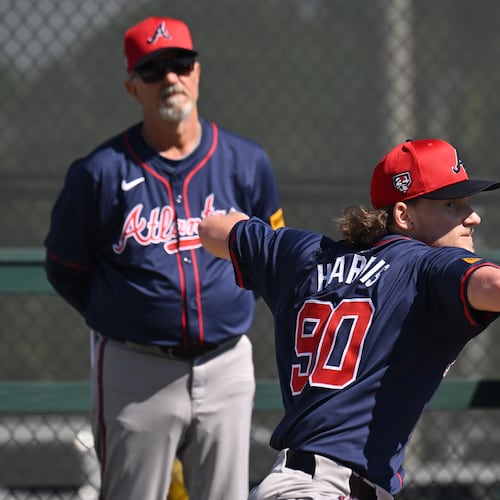NORTH PORT, Fla. – As he reflects now, Spencer Strider realizes that, coming off an oblique injury and heading into the postseason in 2022, he probably didn’t possess the necessary mindset to excel on that stage. In turn, he felt he let down the team.
Last October, he thought his two postseason starts were two of his best – if not his best – mental games of his career. But the Braves lost both. They were eliminated in the first round. Again.
“So, to me, you can say, ‘Well, other circumstances led to the outcomes, it wasn’t me, I did everything I needed to do,’” Strider says. “Or you could say, ‘I did everything I needed to do and it wasn’t enough.’ So then the answer is, ‘I’ve gotta get better.’”
And when Strider pondered how he could take the next step – and, by association, how the team could get back to the World Series – something hit him: He could develop a curveball.
To this point in his young but accomplished career, Strider has relied on his four-seam fastball and his slider. He throws a changeup, but the curveball will fit him better and probably will be more effective.
When you think of Strider, your mind first goes to the electric stuff. It might be the best in baseball. But the right-hander is also defined, at least in part, by his work ethic and intelligence. He pairs those qualities with his talent, and they form a jaw-dropping combination.
New pitch? No problem.
“I don’t put anything past him,” Braves pitching coach Rick Kranitz said. “I don’t.”
The story of Strider learning a curveball is actually a tale of how he re-learned a curveball. He threw a curveball when he was coming off Tommy John surgery years ago. He tabled it when he entered professional baseball because he was focused on becoming a four-seam flamethrower.
But to know the 25-year-old Strider is to understand this: For the most part, he doesn’t believe in flukes. There are almost always explanations behind anything.
So when the Braves bowed out early again, it told him something.
“And so you looked at it and you say, ‘Well, how can I get better?’” Strider said. “And I think that was really my ultimate leading goal of the offseason was like, ‘How can we get better? We didn’t win the World Series, how can I get better?’”
Credit: HYOSUB SHIN / AJC
Credit: HYOSUB SHIN / AJC
The origins of the curveball
In 2021, Strider and Sean McLaughlin, another right-handed pitcher, met in the lunchroom while playing for Double-A Mississippi. Strider was 22 years old and McLaughlin was the minor leaguer who often mentored his younger teammates. Before the two even spoke much, McLaughlin gleaned this: Strider thought differently than others.
During that year, Strider was fastball, fastball and more fastball. He needed another pitch and he sought out McLaughlin. Usually, McLaughlin said, guys want to know about a grip. But Strider wanted to know everything – and in great detail. He wanted to know, for example, how it should feel when it comes off his fingers.
“It was just very detail-oriented questions, immediately,” McLaughlin told The Atlanta Journal-Constitution over the phone. “We didn’t even know each other’s hobbies or what we did off the field or (about our) families. We got right into the nitty gritty of pitching, and that kind of led to a friendship, obviously, down the road. But it was just the detail-oriented questions in our first couple of conversations about pitching and just, really, life, that you could tell he’s a little bit different in the way he goes about it – which is kind of, in my opinion, (what) makes him so elite and successful.”
Let’s fast forward to this winter.
When he wanted to re-introduce a curveball into his repertoire, Strider sought out McLaughlin, who now runs Maven Baseball Lab with his friend, Tyler Krieger. McLaughlin runs the pitching side and Krieger works with the hitters. Along with Strider, Max Fried, Matt Olson, A.J. Minter and others used the facility over the offseason.
At Maven, McLaughlin and Krieger – armed with tons of technology – help players in many ways. As former professional players, they understand how to relay information to big leaguers. They take data from the best players in the game and use it to help their own clients by formulating individual plans.
When he visited Maven before the 2023 season, Strider actually threw a few curveballs. At the time, his slider was backing up – it wasn’t moving properly – so they used the curveball as a way to help Strider gain a better feel for the slider. The curveballs were really good.
“Of course he can do it, because he’s Spencer Strider and he’s really good,” McLaughlin joked with people at the time.
After seeing those curveballs, McLaughlin knew Strider could possibly add the pitch in the future. But he didn’t know whether it would work with the righty’s arsenal.
So when the topic arose again this past offseason, McLaughlin sat down with Paul Davis, Atlanta’s director of pitching development, in January. They basically asked themselves: OK, he can throw this, but is it a good idea for his arsenal and how he pitches? With Davis’ help, the pair dove into the numbers, which said Strider would benefit from the addition.
In January and early February, Strider worked out at Truist Park, but would throw his two weekly bullpen sessions at Maven in front of McLaughlin and the helpful technology. There, he honed the curveball. The data told them that the pitch looked how it should.
One person who saw that curveball before most: Olson, who hits at Maven.
“I think Strider could learn any pitch and go to throw it, and he’ll be just fine as long as he’s got that elite fastball,” Olson said.
Credit: HYOSUB SHIN / AJC
Credit: HYOSUB SHIN / AJC
Why the curveball fits Strider so well
With this curveball, the possibilities are endless. No one – not even Strider – knows what it could become or how it may evolve.
“I think it could be anything,” Strider said.
There are reasons this curveball suits Strider so well. And know this: Strider is the best when it comes to explaining something complex in a simple way.
At the beginning of the process, Strider asked himself: What do I have the opportunity to throw based on how my hand and body work? The curveball made the most sense because of his biomechanical strengths.
An example: Strider has a “very dominant middle finger,” which is why can backspin the ball so well and can throw a hard slider. The curveball is a middle-finger-dominant pitch and it gives Strider velocity difference, so it fits a spot in his pitch profile that wasn’t previously occupied.
“If I could have 15 pitches, I would have 15 pitches, you know? That’d be great,” Strider said. “I could try to throw a sinker. It wouldn’t do anything. I could get (analytical people) to label it a sinker. It wouldn’t sink, if it ever did, and it would be a terrible pitch, so I wouldn’t try to throw one.”
It wouldn’t be a good sinker because Strider doesn’t throw the same way as great sinkerballers. When he throws, he gets behind the ball and his middle finger has a lot of flexibility. He also wouldn’t throw a good splitter in his current form.
This brings us to the changeup, which Strider threw around 7% of the time last season. It has been, in a way, a confusing offering. It offers a velocity difference, but he hasn’t seemed to trust it a ton.
“The changeup is just something a little bit on the outside of what my capabilities are biomechanically, so that’s why I’ve had to be weird about it and understand what its limits are, have reasonable expectations for it and what its movement profile is gonna look like,” Strider said. “I’m always kind of still learning about how I can make it more consistent. I think that’s my thing with the changeup is I want it to be consistent.
“The curveball is a pitch that can be really good.”
He can throw triple digits with his four-seam fastball. His slider averages around 86 mph, and can go a few ticks up. Thus far, the curveball has been high-70s to low-80s.
“It’s different. It’s a slower pitch, right?” said Kranitz, Atlanta’s pitching coach. “It will affect the timing of the hitter. There’s a lot hitters (that), obviously when you throw so hard, they just sit hard. So now all of the sudden you start adding something else in to disrupt timing, that’s only a good thing.”
The metrics taken at Maven said the curveball is good. The Braves’ catchers, Sean Murphy and Travis d’Arnaud, have praised it. And now, the hitters’ swings are telling.
“It’s just another change of pace,” Murphy said recently. “...We’ll see how we use it. We don’t necessarily know how it’s going to fit yet, but we’ll nail it down.”
‘I think he could be the best pitcher in baseball’
A year ago, Strider set the Braves franchise record for strikeouts in a single season, with 281. In two major-league seasons, he’s already become one of the best starting pitchers in baseball.
But the outcomes – the postseason results – told him he needed to improve. So he added another pitch.
A word to opponents: Good luck.
“I think he could be the best pitcher in baseball,” McLaughlin said. “If he keeps going along this path and if he keeps improving and thinking the way he is right now, I think the sky’s the limit for him. In my opinion, it’s just kind of up to him and how far he wants to take it – because he’ll take it further than anybody, and it’s pretty fun to watch from the sidelines.”
About the Author
Keep Reading
The Latest
Featured





